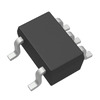Manufacturer Part Number
TLV7041QDBVRQ1
Manufacturer
Texas Instruments
Introduction
The TLV7041QDBVRQ1 is a high-performance, single-channel linear comparator from Texas Instruments, designed specifically for automotive and industrial applications.
Product Features and Performance
Single comparator element
Open-Drain, Rail-to-Rail output type
Very low voltage operation ranging from 1.6V to 6.5V
Maximum input offset voltage of 8mV at 5V
Extremely low input bias current, 2pA at 5V
Output current typically 40mA at 5V
Maximum quiescent current of 900nA
Excellent CMRR and PSRR of 73dB and 77dB respectively
Fast propagation delay of maximum 3µs
Built-in hysteresis of 17mV
Product Advantages
Ideal for battery-powered applications due to ultra-low power consumption
Precise performance with low voltage and current requirements
Robust output drive and rail-to-rail output increases versatility
Automotive-grade reliability and performance
Key Technical Parameters
Supply Voltage: 1.6V ~ 6.5V
Input Offset Voltage (Max): 8mV
Input Bias Current (Max): 2pA
Output Current (Typical): 40mA
Quiescent Current (Max): 900nA
CMRR, PSRR (Typical): 73dB, 77dB
Propagation Delay (Max): 3µs
Operating Temperature Range: -40°C ~ 125°C
Quality and Safety Features
Automotive-grade (AEC-Q100 qualification)
Robust operating temperature range ensuring stability in harsh environments
Compatibility
Compatible with a wide range of supply voltages and logic levels due to rail-to-rail output
Application Areas
Automotive systems
Industrial control systems
Battery management systems
Power supply control
Product Lifecycle
Currently active product status, not nearing discontinuation
Availability of replacements or upgrades is maintained by Texas Instruments
Several Key Reasons to Choose This Product
Exceptionally low power consumption suitable for battery-operated devices
High reliability and performance that meet automotive and industrial standards
Versatile with high output drive and compatibility with multiple supply voltages and logic levels
Fast response time enhanced by low propagation delay
Minimal design adjustments needed due to stable operation across extreme temperature ranges




 TLV70333DBVTTexas Instruments
TLV70333DBVTTexas Instruments TLV70430DBV
TLV70430DBV TLV7041DPWRTexas InstrumentsIC COMPARATOR 1 GEN PUR 5X2SON
TLV7041DPWRTexas InstrumentsIC COMPARATOR 1 GEN PUR 5X2SON TLV7034PWRTexas InstrumentsIC COMPARATOR 4 GEN PUR 14TSSOP
TLV7034PWRTexas InstrumentsIC COMPARATOR 4 GEN PUR 14TSSOP TLV70430DBVTTexas InstrumentsIC REG LINEAR 3V 150MA SOT23-5
TLV70430DBVTTexas InstrumentsIC REG LINEAR 3V 150MA SOT23-5 TLV7042QDGKRQ1Texas InstrumentsIC COMPARATOR 2 GEN PUR 8VSSOP
TLV7042QDGKRQ1Texas InstrumentsIC COMPARATOR 2 GEN PUR 8VSSOP